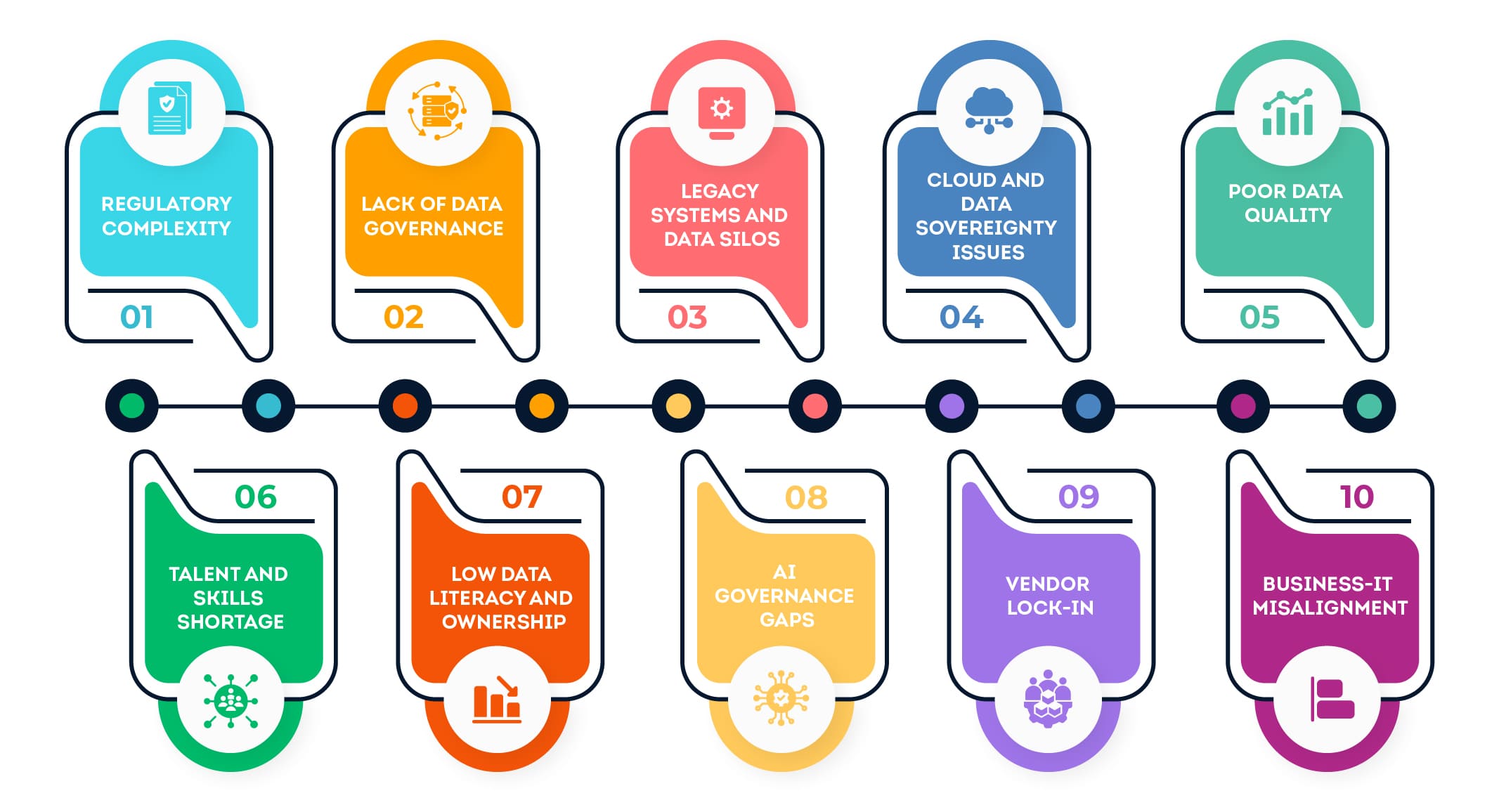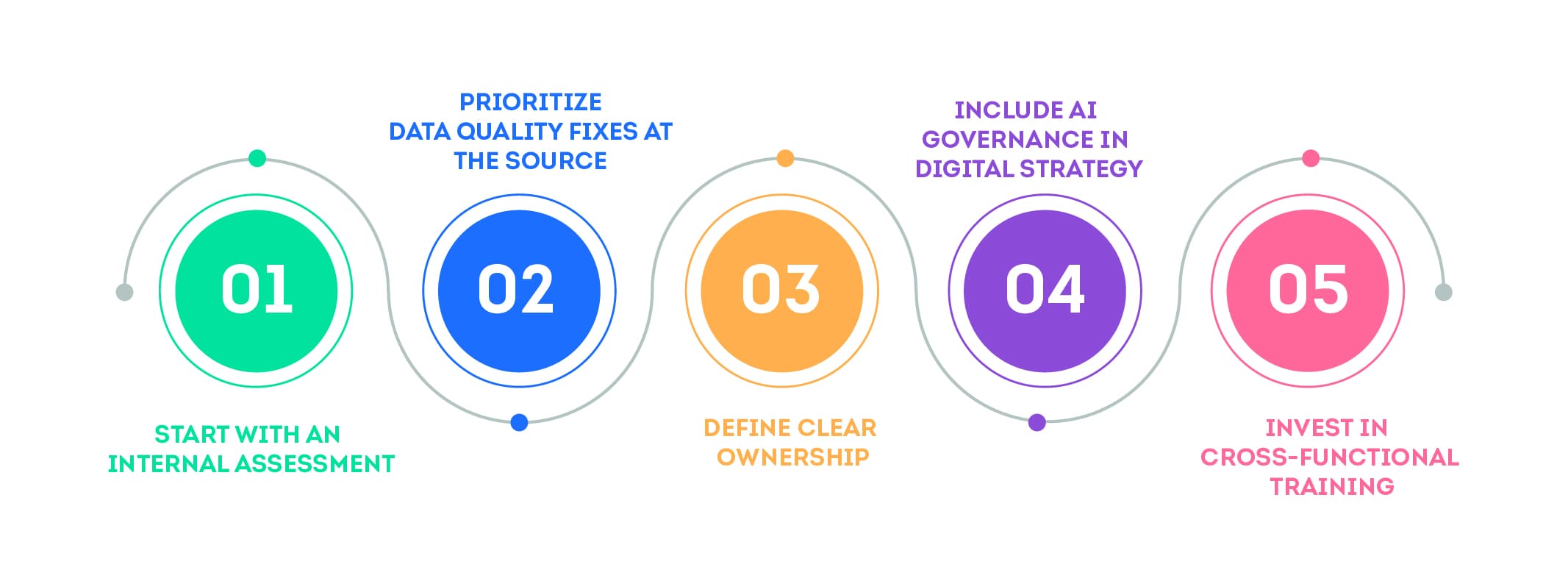Digital transformation across the Middle East is progressing at a remarkable pace with the market projected to grow from $1.48 billion in 2024 to $2.58 billion by 2029, reflecting a CAGR of 11.8%. Countries like Saudi Arabia, the UAE, and Qatar are leading the charge with national agendas, such as Vision 2030, the Digital Government Strategy, and Qatar National Vision 2030, reshaping how industries operate, and public services are delivered.
However, beneath the visible progress, one persistent issue continues to challenge organizations: a low data management maturity. While some sectors are making meaningful strides—banking, driven by tight regulations and digital innovation, and government entities, supported by national digitization agendas—others are lagging. Industries like retail, oil & gas, and manufacturing face ongoing hurdles from legacy systems, fragmented operations, and a lack of digital readiness, putting effective data management out of reach.
From regulatory compliance to poor data quality, this article examines the top data management challenges and outlines some key initiatives that organizations can implement to address them.
Data Management Challenges in the Middle East
- Regulatory Complexity: Governments are establishing new standards for the storage and utilization of data. In Saudi Arabia, companies must comply with the NDMO and PDPL, while also considering GDPR and data residency laws if they operate across borders. For large enterprises, particularly those in the banking, healthcare, or energy sectors, the compliance burden is substantial. And when interpretations vary, for example, between what regulators in Riyadh expect versus those in Dubai, it creates gaps, overlaps, and costly revisions.
- Lack of Data Governance: Many businesses view data ownership as a purely technical task. However, when no single department is responsible for accuracy or access control, inconsistencies are likely to arise. KPIs don’t align. Reports don’t match. This can cause delays during audits or derail automation efforts. Without defined data stewards and clear governance policies, the best-intentioned data projects will eventually stumble.
- Legacy Systems and Data Silos: Across sectors such as construction, oil and gas, and logistics, outdated systems continue to handle key operations. These tools weren’t built for real-time visibility or system-wide integration, and it shows. When procurement is on one platform, inventory is on another, and reporting is handled manually in Excel, organizations lose the ability to move quickly. This bottleneck frustrates leadership and makes strategic forecasting unreliable.
- Cloud and Data Sovereignty Issues: Cloud migration is happening, but not without caveats. Saudi Arabia’s CCRF mandates that sensitive data stay on local servers, and similar expectations are being enforced elsewhere in the GCC. Multinationals must juggle regional data rules with global policies, leading some to adopt hybrid models: part cloud, part on-premises. While effective in the short term, this approach often results in complex integrations and increased infrastructure costs.
- Poor Data Quality: Regional data audits often reveal issues such as missing customer records, mismatched transaction logs, or duplicate supplier profiles. These problems become particularly visible during mergers and acquisitions (M&A) due diligence or when implementing enterprise platforms, such as SAP or Salesforce.
- Talent and Skills Shortage: While demand for data professionals is growing fast, supply hasn’t kept pace. Many organizations compete for a limited pool of skilled data engineers, analysts, and AI auditors. Some organizations rely on external partners for execution, which can limit their ability to be agile and responsive. Others delay projects, unsure whether in-house teams can manage once vendors roll off.
- Low Data Literacy and Ownership: Business units often rely on dashboards and reports but hesitate to question the logic behind them. That creates a disconnect between data availability and its practical use. Encouragingly, a few regional banks and telecom firms are introducing data upskilling in non-technical departments. Still, broad awareness remains limited, and without cultural buy-in, transformation slows.
- AI Governance Gaps: AI tools are increasingly embedded into pricing, forecasting, and customer analytics. But oversight is often minimal. Bias checks, model explainability, and version control are rarely formalized. A retailer in the region recently paused an AI-based discount engine after inconsistent results flagged pricing errors. The root cause? No structured review of training data or outputs.
- Vendor Lock-in: Companies that standardize on single-vendor systems often find themselves locked in. These platforms aren’t always flexible or affordable to extend, and switching out is rarely straightforward. Firms exploring open ecosystems or composable architectures often face significant internal resistance due to concerns about integration and long-standing procurement ties.
- Business-IT Misalignment: When data projects are led exclusively by IT or compliance, business impact tends to get overlooked. Dashboards get built; policies are written, but frontline teams may not engage or adapt. To deliver results, a data strategy must serve top-line goals—whether it is customer growth, operational efficiency, or faster decision-making cycles.
The Cost of Poor Data Management
Poor data management can lead to:
- Missed revenue opportunities due to poor forecasting
- Audit failures linked to weak access controls
- Slowed AI adoption because data can’t be trusted
Data Management Solutions
There’s no quick fix, but businesses can take a more structured approach to overcome these data management hurdles:
- Start with an internal assessment: Map your data flows, access controls, and governance gaps. Paramount’s maturity assessments, aligned with DAMA and DCAM frameworks, benchmark the current state and shape a tailored improvement roadmap.
- Prioritize data quality fixes at the source: Focus on core systems, like ERP or CRM, where most decisions are anchored. Paramount deploys tools and frameworks for data profiling, standardization, and continuous auditing, ensuring clean, reliable data upstream.
- Define clear ownership: Appoint business-aligned data stewards who can bridge the gap between IT and functional teams, ensuring seamless integration.
- Include AI governance in digital strategy: Develop guidelines around model transparency, auditability, and training data hygiene before scaling. Paramount embeds AI governance into the organization’s data strategy with tailored controls mapped to regional regulations.
- Invest in cross-functional training: Beyond IT, train marketing, operations, and finance teams to work confidently with data and understand its implications. By grounding data efforts in business strategy—not just regulatory checklists—organizations can turn what is often viewed as a burden into a competitive differentiator. Paramount runs role-based training across functions like marketing, finance, and operations, reinforcing data as a shared asset.
Conclusion
Modernizing data infrastructure is not a quick win. It’s a strategic undertaking that unfolds over months or even years. It requires clarity, coordination, and in many cases, the right support system. As a regional leader in digital security and data governance, Paramount helps businesses across the Middle East align data strategy with enterprise goals. Whether it’s setting up data management frameworks to meet PDPL and NDMO requirements, enabling hybrid cloud adoption, or developing AI oversight policies, Paramount combines regional insight with global best practices to deliver measurable results. Schedule a consultation to get customized data management solutions for your business.


